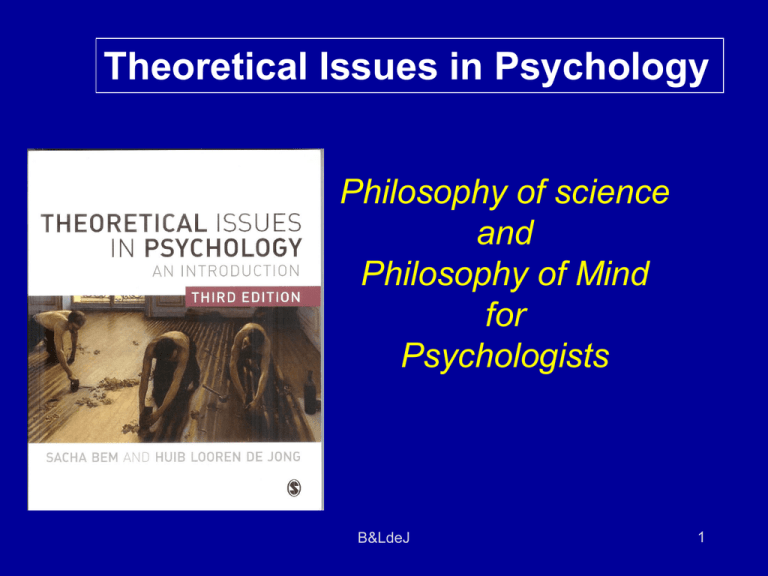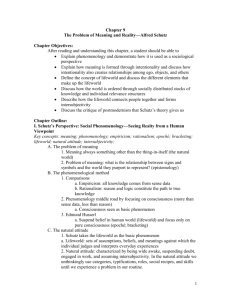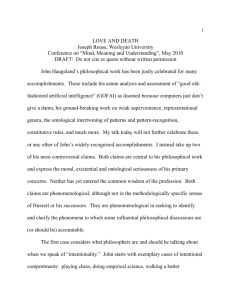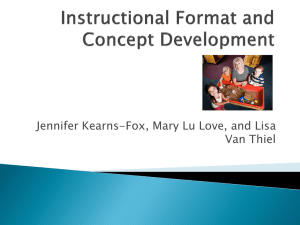Chapter 6 PowerPoint
advertisement

Theoretical Issues in Psychology Philosophy of science and Philosophy of Mind for Psychologists B&LdeJ 1 Chapter 6 Philosophy of mind, brain and cognition • What is mind? •Traditional views on the nature of mind: dualism, materialism, behaviourism. • Aspects of mind: intelligence and consciousness. • Intentionality: another aspect of mind. • Various interpretations of intentionality. • Folk psychology, intentionality and mindreading. • Mental causation. • Three perspectives on mind and brain: multiplicity of explanations. • Explanations in the study of mind, B&LdeJ 2 brain and agency. Philosophy of mind Questions and issues: • • • • • What are mental states and processes? What is the relation between mental and physical? How do thoughts refer to things? What is the status of ‘folk psychology’? What is consciousness? (Ch. 10) B&LdeJ 3 Different views on mind/body-brain Dualism • ontological (two substances); • epiphenomenalism (mind is by-product); • property dualism (double-aspects, same substance); • methodological (two methods, not substances). Behaviourism • epiphenomenalism (‘black box’); • operationalism (only behaviour terms); • linguistic behaviourism (Ryle). Materialism • identity theory (IT) (mind = brain); • functionalism (‘classical’ or ‘orthodox’ cognitivism); • connectionism / dynamism: Ch. 8. B&LdeJ 4 Linguistic behaviorism Gilbert Ryle: The Concept of Mind (1949) 1. Do not say: we have… a body (outer behavior) and a mind (inner theater) CATEGORY-MISTAKE 2. Replace ‘intern mental theater’ by: behavioral dispositions. 3. Mind is behavior of the body: clever acting. 4. Linguistic behaviorism: mental terms refer to behavior (not to inner processes). B&LdeJ 5 Three features of mind • Intelligence: • reasoning, rationality; • reasoning is reckoning; computation; AI; • but more than reasoning: intentions, emotions, motivations, actions. • Consciousness: • subjective, essentially private; • qualia (first-person experience); • can qualia be explained objectively (third person)? • consciousness and brain (Ch. 10). • Intentionality: • the mark of the mental: aboutness; • directed at intentional object (seeing, wanting something); • beliefs and desires; B&LdeJEvolution? • can intentionality be naturalized? 6 Intentionality • Is a property of psychological phenomena of being about things; being directed to objects. • It is the aboutness of mental states (such as, believing, desiring, hearing, mourning etc.). • Mental states have content. • Mental states are directed towards factual or counterfactual (existing or non-existing) things and events. • Notions like representation, meaning and mental content are closely related to intentionality. • These all refer to the ability of mental or cognitive states to indicate something beyond themselves. B&LdeJ 7 ‘Original’ and ‘derived’ intentionality John Searle Billboards and books don’t have original intentionality. Someone put the meaning there for everyone who can read and understand the signs or symbols. So, these things have only derived intentionality. B&LdeJ 8 Phenomenologists and materialist on intentionality Franz Brentano (1838–1917) and early phenomenologists: Mind differs essentially from matter: only psychological phenomena have intentionality, not physical things. Materialists: Physical things and processes are all there is; so, intentionality should be naturalized, that is explained in physical, computational or biological terms. Or (another strategy), eliminated from scientific worldview, since it is part of a folk-psychological worldview. B&LdeJ 9 Fodor’s cognitive linguistic explanation of intentionality A mental state is a propositional attitude: ‘He thinks that he is Napoleon’ ‘She expects that he will come tonight’ The content is the proposition (that-clause). These propositional attitudes (mental states) cause behavior or other mental states: e.g., wearing a Napoleon-hat all day; or thinking he loves good food and cooking the best meal ever. B&LdeJ 10 Fodor’s explanation of intentionality – 2 Propositional attitudes (mental states) do their causal work, are intentional, irrespective of the existence or reality of the content / the proposition (the that-clause). It is the syntax of the propositional attitude that causes behaviour, regardless of reference to the world. Therefore only the syntax, only what happens inside the head is psychological important, not the reference to the world, the semantics / the meaning / the content of the mental states. The psychologist or cognitivist can be a solipsist in her method, can be world-aloof. Hence ‘Methodological Solipsism’ B&LdeJ 11 Daniel Dennett’s solution Intentionality is a way of speaking We normally attribute thoughts, desires, fears and reasons to intentional systems (human beings, chess-computers etc.). This intentional idiom and psychological strategy works well: it produces accounts, explanations, predictions of behavior. But we should not be tempted to take it literally, that beliefs and desires exist somewhere at the physiological level of brain states. The intentional idiom is a useful, even indispensible folkpsychological approach, but scientists should trade it in when naturalistic explanations happen to be found. B&LdeJ 12 Intentionality is a feature of information Fred Dretske Intentionality is a ‘pervasive feature of all reality – mental and physical’, rather than a ‘mark of the mental’. E.g., the thermometer is sensitive to the value of the temperature it is designed to measure. Any physical system which can carry information in this way is an intentional system. B&LdeJ 13 Ecological conception of intentionality Intentionality is the property of a complete being who is cognitive and active in the world. Cognitive activities work in the interaction between organism and environment. Intentionality gets a kind of ecological interpretation, an organism’s situatedness in the world. B&LdeJ 14 Intentionality as being in the world Second generation of (existential) phenomenologists, like Martin Heidegger and Maurice Merleau-Ponty had also a broad conception of intentionality in mind. Martin Heidegger Intentionality expresses the property of our human engagement with the world. It characterizes human existence, human living and acting in the world. They called this ‘being-in-the-world’: ‘Dasein’, ‘être au monde’. Maurice Merleau Ponty B&LdeJ 15 Folk psychology 1. Common-sense psychology we use in everyday life (in clinical and social psychology, and in economics), understanding, explaining, predicting behavior, as guided by goals, thoughts, and reasons: ‘He must be crazy, for dumping her’; ‘Mary had not the slightest desire to go on holiday’. 2. A philosophical reconstruction: the application of common sense notions to mental states as representing, having content and aboutness, the ‘belief-desire’ model of mental states, the LOT-model. B&LdeJ 16 How is mind-reading possible? Three approaches (theories): 1. the theory theory: we have an an inborn capacity, an inner theory, a module, to reason about others’ thoughts and feelings; this theory fits in the project of naturalizing the mind; 2. the simulation theory: we simulate what we would do, think or feel when we put ourselves in the other’s shoes; 3. a kind of hermeneutic explanation: the capacity is like ‘Verstehen’, recreating the other’s state of mind from our own subjectivity, in a holistic way and not exhausted by a complete specification of rules; is an intersubjective understanding (‘co-cognition’); an antinaturalistic approach. B&LdeJ 17 Mental causation: a place for mind in a physical world? (Reductionistic) Materialism and Epiphenomenalism No! Thinking is just a physical process, ‘mental causes’are really brain processes. Mind does not exist, or its processes are no more than by-products. Mental causation – mental realism Yes! Mental processes like thinking and willing cause behavior; thoughts must be real, and have causal powers. Anomalous monism (Davidson) Yes! Mental processes are brain processes (monism) and have causal powers, but they cannot be reduced to brain processes, they make no nomological (lawful) connections (are anomalous). B&LdeJ 18 Dennett’s 3 stances_1 • Physical stance: the level of implementation, hardware, brain (cfr.the engine of a car). • Design stance: the level of design, the functional structure: the cognitive system, the software (cfr. the design of a car). • Intentional stance: the level of behavior, of intentional explanation (cfr. the car’s performance). B&LdeJ 19 Dennett’s 3 stances_2 • The intentional stance uses beliefs and desires to explain and predict complex intelligent systems. Intentional explanation is a loan on intelligence that must be redeemed by specifying the design (computer program, electronic circuits, etc.) that produces intentional behavior. • The design stance predicts a system’s behavior by breaking it up into functional parts and showing how these subsystems or subroutines perform their (sub)tasks. • The physical stance predicts the system from its physical states, and is usually invoked to explain malfunction. B&LdeJ 20 Multiple perspectives in explaining mind, brain and agency • Multiple levels and perspectives of studying mind and brain. • Explanatory pluralism, pragmatism: what works as explanation and prediction. • Intentional explanations in folk psychology, design and physical explanations in cognitive and neuroscience, can coexist. • No reduction. B&LdeJ 21











